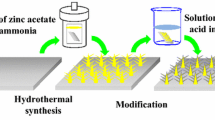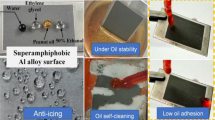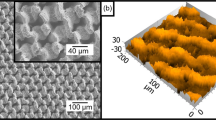Abstract
Superhydrophobic aluminum (Al) surfaces are desired in many applications and have been widely studied, but some fundamental issues in their fabrication are not yet fully understood. In this study, commonly used HCl solution and organic acid/sulfur reagents were employed for clarifying the phenomena in etching and composition modification. An unstable layer was revealed after HCl etching, which was removable with water flushing, and this layer, consisting of scattered AlCl3/Al2O3 particles surrounded by Al2O3 plates with cracks, caused changes in surface appearance from bright to dark. A complete change in surface color corresponded to sufficient etching, and hence, this visible phenomenon could be used to confirm the shortest etching time for achieving desirable superhydrophobicity. Composition modification with dodecanethiol and myristic acid also modified the microstructure through a slight etching mechanism and a synergistic effect was found with the use of their mixture, which led to the finest grains and most abundant carbon chains on the final surfaces. Consequently, the best superhydrophobicity was revealed in static and dynamic experiments with droplets. Finally, using the advantage of flexibility, a superhydrophobic Al sheet was demonstrated to be suitable for subjecting droplets to controlled rolling and coalescence, which could be meaningful for many droplet-related studies.










Similar content being viewed by others
References
Barthlott W, Neinhuis C (1997) Purity of the sacred lotus, or escape from contamination in biological surfaces. Planta 202:1–8
Neinhuis C, Barthlott W (1997) Characterization and distribution of water-repellent, self-cleaning plant surfaces. Ann Bot 79:667–677
Xing R, Latthe SS, Bhosale AK, Li R, Kumar AM, Liu S (2017) A novel and facile approach to prepare self-cleaning yellow superhydrophobic polycarbonates. J Mol Liq 247:366–373
Yin K, Dong X, Zhang F, Wang C, Duan JA (2017) Superamphiphobic miniature boat fabricated by laser micromachining. Appl Phys Lett 110:121909
Li XG, Zou LP, Xu LL, Shen J (2012) A superhydrophobic surface prepared by the combination of two sizes of silica particles. Rare Met Mater Eng 41:144–146
Qu M, Yuan M, Liu S, He J, Xue M, Liu X, Li S, He J (2018) A versatile and efficient method to fabricate recyclable superhydrophobic composites based on brucite and organosilane. J Mater Sci 53:396–408. https://doi.org/10.1021/la0607757
Li XG, Shen J (2011) A facile two-step dipping process based on two silica systems for a superhydrophobic surface. Chem Commun 47:10761–10763
He J, He J, Yuan M, Xue M, Ma X, Hou L, Zhang T, Liu X, Qu M (2018) Facile fabrication of eco-friendly durable superhydrophobic material from eggshell with oil/water separation property. Adv Eng Mater 20:1701180
Luo H, Yin S, Zhang G, Tang Q, Gen J, Huang S (2017) Study of superhydrophobic surface in self-cleaning of magnetorheological fluid. J Mater Sci 53:1–12. https://doi.org/10.1021/la0401011
Kim S, Hwang H, Cho H, Choi D, Hwang W (2018) Repeatable replication method with liquid infiltration to fabricate robust, flexible, and transparent, anti-reflective superhydrophobic polymer films on a large scale. Chem Eng J 350:225–232
Boyer Q, Duluard S, Tenailleau C, Ansart F, Turq V, Bonino JP (2017) Functionalized superhydrophobic coatings with micro-/nanostructured ZnO particles in a sol–gel matrix. J Mater Sci 52:12677–12688. https://doi.org/10.1021/la301479c
Ye Y, Liu Z, Liu W, Zhang D, Zhao H, Wang L, Li X (2018) Superhydrophobic oligoaniline-containing electroactive silica coating as pre-process coating for corrosion protection of carbon steel. Chem Eng J 348:940–951
Huang Z, Gurney RS, Wang T, Liu D (2018) Environmentally durable superhydrophobic surfaces with robust photocatalytic self-cleaning and self-healing properties prepared via versatile film deposition methods. J Colloid Interface Sci 527:107–116
Xu L, Shen Y, Ding Y, Wang L (2018) Superhydrophobic and ultraviolet-blocking cotton fabrics based on TiO2/SiO2 composite nanoparticles. J Nanosci Nanotechnol 18:6879–6886
Li XG, Shen J (2013) Deforming water droplets with a superhydrophobic silica coating. Chem Commun 49:10016–10018
Qu M, Ma X, He J, Feng J, Liu S, Yao Y, Hou L, Liu X (2016) Facile selective and diverse fabrication of superhydrophobic, superoleophobic-superhydrophilic and superamphiphobic materials from kaolin. ACS Appl Mater Interfaces 9:1011–1020
Zang D, Zhu R, Zhang W, Yu X, Lin L, Guo X, Liu M, Jiang L (2017) Corrosion resistance: corrosion-resistant superhydrophobic coatings on mg alloy surfaces inspired by lotus seedpod. Adv Funct Mater 27:1605446
Schutzius TM, Jung S, Maitra T, Graeber G, Köhme M, Poulikakos D (2015) Spontaneous droplet trampolining on rigid superhydrophobic surfaces. Nature 527:82
Bormashenko E, Bormashenko Y (2011) Non-stick droplet surgery with a superhydrophobic scalpel. Langmuir 27:3266
Mulroe M, Srijanto B, Collier P, Boreyko J (2017) Tuning superhydrophobic nanostructures to enhance jumping-droplet condensation. ACS Nano 11:8499
Li XG, Shi HX, Wang YQ, Wang RX, Huang S, Huang JC, Geng XG, Zang DY (2017) Liquid shaping based on liquid pancakes. Adv Mater Interfaces 5:1701139
Li XG, Xue YH, Lv PY, Lin H, Du F, Hu YY, Shen J, Duan HL (2016) Liquid plasticine: controlled deformation and recovery of droplets with interfacial nanoparticle jamming. Soft Matter 12:1655–1662
Wang N, Xiong D, Deng Y, Shi Y, Wang K (2017) Mechanically robust superhydrophobic steel surface with antiicing, uv-durability, and corrosion resistance properties. ACS Appl Mater Interfaces 7:6260–6272
Wang N, Tang L, Tong W, Xiong D (2018) Fabrication of robust and scalable superhydrophobic surfaces and investigation of their anti-icing properties. Mater Des 156:320–328
Wang N, Tang L, Cai Y, Tong W, Xiong D (2018) Scalable superhydrophobic coating with controllable wettability and investigations of its drag reduction. Colloids Surf A 555:290–295
Yin B, Fang L, Hu J, Tang AQ, He J, Mao JH (2012) A facile method for fabrication of superhydrophobic coating on aluminum alloy. Surf Interface Anal 44:439–444
Saleema N, Sarkar DK, Paynter RW, Chen XG (2010) Superhydrophobic aluminum alloy surfaces by a novel one-step process. ACS Appl Mater Interfaces 2:2500–2502
Xie D, Li W (2011) A novel simple approach to preparation of superhydrophobic surfaces of aluminum alloys. Appl Surf Sci 258:1004–1007
Wang H, Dai D, Wu X (2008) Fabrication of superhydrophobic surfaces on aluminum. Appl Surf Sci 254:5599–5601
Liu W, Luo Y, Sun L, Wu R, Jiang H, Liu Y (2013) Fabrication of the superhydrophobic surface on aluminum alloy by anodizing and polymeric coating. Appl Surf Sci 264:872–878
Feng L, Zhang H, Wang Z, Liu Y (2014) Superhydrophobic aluminum alloy surface: fabrication, structure, and corrosion resistance. Colloids Surf A 441:319–325
Bernagozzi I, Antonini C, Villa F, Marengo M (2014) Fabricating superhydrophobic aluminum: an optimized one-step wet synthesis using fluoroalkyl silane. Colloids Surf A 441:919–924
Esmaeilirad A, Rukosuyev M, Jun M, Veggel F (2016) A cost-effective method to create physically and thermally stable and storable super-hydrophobic aluminum alloy surfaces. Surf Coat Technol 285:227–234
Zuo Z, Liao R, Guo C, Yuan Y, Zhao X, Zhuang A, Zhang YY (2015) Fabrication and anti-icing property of coral-like superhydrophobic aluminum surface. Appl Surf Sci 331:132–139
Wu RM, Jiang HY, Liu WY, Deng J, Yuan ZQ, Liu QL, Chen H (2012) Bacteriostasis of a super-hydrophobic micro-porous aluminum surface by a facile preparation method. Adv Mater Res 583:346–349
Zhang B, Xu W, Zhu Q, Li Y, Hou B (2018) Ultrafast one step construction of non-fluorinated superhydrophobic aluminum surfaces with remarkable improvement of corrosion resistance and anti-contamination. J Colloid Interface Sci 532:201–209
Ngo C, Chun D (2018) Control of laser-ablated aluminum surface wettability to superhydrophobic or superhydrophilic through simple heat treatment or water boiling post-processing. Appl Surf Sci 435:974–982
Song Y, Wang X, Dong X, Yin K, Zhang F, Xie Z, Chu D, Duan J (2018) Controllable superhydrophobic aluminum surfaces with tunable adhesion fabricated by femtosecond laser. Opt Laser Technol 102:25–31
Li XG, Wang YQ, Yang Y, Wang SH, Zang DY, Geng XG (2018) Dynamic behavior of droplets under interfacial jamming of nanoparticles. Appl Phys Lett 113:133702
Li XG, Wang RX, Shi HX, Song BH (2018) Effective surface tension of liquid marbles using controllable nanoparticle monolayers. Appl Phys Lett 113:101602
Li XG, Wang YQ, Huang JC, Yang Y, Wang RX, Geng XG, Zang DY (2017) Monolayer nanoparticle-covered liquid marbles derived from a sol–gel coating. Appl Phys Lett 111:261604
Li XG, Wang RX, Huang S, Wang YQ, Shi HX (2018) A capillary rise method for studying the effective surface tension of monolayer nanoparticle-covered liquid marbles. Soft Matter 8:8–9. https://doi.org/10.1039/c8sm01846d
Li XG, Wang YQ, Wang RX, Wang SH, Zang DY, Geng XG (2018) A dip-decoating process for producing transparent bi-superhydrophobic and wrinkled water surfaces. Adv Mater Interfaces 5:1800356
Su B, Wang S, Song Y, Jiang L (2011) A miniature droplet reactor built on nanoparticle-derived superhydrophobic pedestals. Nano Res 4:266–273
Chu Y, Wang Z, Pan Q (2014) Constructing robust liquid marbles for miniaturized synthesis of graphene/ag nanocomposite. ACS Appl Mater Interfaces 6:8378
Sarvi F, Jain K, Arbatan T, Verma PJ, Hourigan K, Thompson MC, Shen W, Chan PP (2015) Cardiogenesis of embryonic stem cells with liquid marble micro-bioreactor. Adv Healthc Mater 4:77–86
Vadivelu RK, Kamble H, Munaz A, Nguyen NT (2017) Liquid marbles as bioreactors for the study of three-dimensional cell interactions. Biomed Microdevices 19:31
Li H, Peng L, Kaur G, Xi Y, Yang M (2017) Transparent and gas-permeable liquid marbles for culturing and drug sensitivity test of tumor spheroids. Adv Healthc Mater 6:1700185
Fujii S, Suzaki M, Armes SP, Dupin D, Hamasaki S, Aono K, Nakamura Y (2011) Liquid marbles prepared from ph-responsive sterically stabilized latex particles. Langmuir 27:8067–8074
Oliveira NM, Reis RL, Mano JF (2017) The potential of liquid marbles for biomedical applications: a critical review. Adv Healthc Mater 6:1700192
Jiaqiang E, Jin Y, Deng Y, Zuo W, Zhao X, Han D, Peng Q, Zhang Z (2017) Wetting models and working mechanisms of typical surfaces existing in nature and their application on superhydrophobic surfaces: a review. Adv Mater Interfaces 5:1701052
Jeevahan J, Chandrasekaran M, Joseph GB, Durairaj RB, Mageshwaran G (2018) Superhydrophobic surfaces: a review on fundamentals, applications, and challenges. J Coat Technol Res 15:231–250
Acknowledgement
This work was financially supported by the National Natural Science Foundation of China (Grant No. 51672224), Shaanxi Provincial Natural Science Foundation (Grant No. 2018JM1002), the Fundamental Research Funds for the Central Universities (Grant No. 3102018zy037), and Opening Project of Shanghai Key Laboratory of Special Artificial Microstructure Materials and Technology (Grant No. ammt2017A-1).
Author information
Authors and Affiliations
Corresponding author
Rights and permissions
About this article
Cite this article
Wang, Y., Shi, H. & Li, X. Revisiting the fabrication of superhydrophobic aluminum surfaces and their use as soft substrates for droplet manipulation. J Mater Sci 54, 7469–7482 (2019). https://doi.org/10.1007/s10853-018-03273-y
Received:
Accepted:
Published:
Issue Date:
DOI: https://doi.org/10.1007/s10853-018-03273-y




